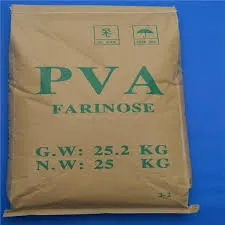Exploring HPMC Hydroxypropyl Methylcellulose and Its Applications
Hydroxypropyl Methylcellulose (HPMC) is a versatile polymer that has garnered significant attention across various industries due to its unique properties and diverse applications. Derived from cellulose, HPMC is a hydrophilic, gel-forming agent that is widely used in pharmaceuticals, food products, cosmetics, and construction materials, among others. Understanding the characteristics and applications of HPMC provides insights into its growing prominence in modern formulations.
Composition and Properties
HPMC is synthesized through the etherification of cellulose, a natural polymer obtained from plant fibers. The process involves the introduction of hydroxypropyl and methoxy groups onto the cellulose backbone, resulting in a compound that exhibits enhanced solubility and functionality. The degree of substitution (DS) of methoxy and hydroxypropyl groups can be tailored, influencing the solubility, viscosity, and gel strength of the polymer. As a result, HPMC is often available in various grades, which can be selected based on specific application requirements.
One of the most notable properties of HPMC is its ability to dissolve in hot or cold water, forming a clear, viscous solution. This makes it an excellent thickening agent and stabilizer. Its film-forming ability also allows it to create protective coatings that can control drug release or act as barriers in food and cosmetics. Moreover, HPMC is non-toxic and soluble in both organic solvents and water, enhancing its usability in different environments.
Applications in Pharmaceuticals
In the pharmaceutical industry, HPMC is widely used as a binder, disintegrant, and controlled-release agent in tablet formulations. Its excellent film-forming properties allow for the development of extended-release formulations, which are crucial for maintaining consistent therapeutic levels of medication in the bloodstream. Additionally, HPMC is utilized in ophthalmic preparations as a lubricant, providing relief for dry eyes. Its biocompatibility and non-irritating properties make it a preferred choice in various therapeutic applications.
Role in Food Products
hpmc cellulose hydroxypropyl methyl

HPMC is also recognized for its functional benefits in the food industry. As a food additive, it serves as a thickener, emulsifier, and stabilizer, enhancing the texture and shelf-life of products. For instance, HPMC is commonly used in gluten-free baking, improving the elasticity and structure of dough without the need for traditional gluten. Furthermore, it aids in fat reduction strategies by providing a creamy mouthfeel, making it an effective ingredient in low-fat and reduced-calorie food products.
Applications in Cosmetics and Personal Care
In the cosmetics sector, HPMC serves multiple purposes, acting as a thickening agent, film former, and stabilizer in formulations such as lotions, creams, and shampoos. Its ability to enhance the viscosity of products while imparting a smooth, luxurious feel on the skin makes it a favored ingredient among formulators. Additionally, HPMC can also be used in hair styling products, providing hold and texture without leaving a greasy residue.
Impact on Construction Industry
The construction industry has also benefitted from HPMC, where it is used as a key additive in cement and mortar formulations. HPMC improves workability, water retention, and adhesion, leading to better performance characteristics in construction materials. Its role in preventing cracking and enhancing the durability of structures highlights its importance in modern construction practices.
Conclusion
In summary, Hydroxypropyl Methylcellulose (HPMC) plays a critical role across various industries due to its unique properties and versatility. From pharmaceuticals to food products, cosmetics to construction, HPMC demonstrates its value in enhancing product quality and performance. As research continues and demands for sustainable and effective solutions grow, HPMC is likely to remain a cornerstone in both existing and emerging applications, driving innovation and efficiency in formulation technologies.
-
The Application and Significance of Construction RdpNewsMay.19,2025
-
Industrial Grade HpmcNewsMay.19,2025
-
Building Coating Adhesive Building Coating Adhesive HpmcNewsMay.19,2025
-
Application Of Hpmc For Detergent For Detergent In DetergentsNewsMay.19,2025
-
Application Of Hpmc Cellulose In Cement-Based MaterialsNewsMay.19,2025
-
Application Of High Quality Hpmc For Construction In The Field Of ConstructionNewsMay.19,2025




